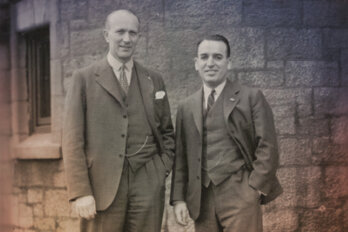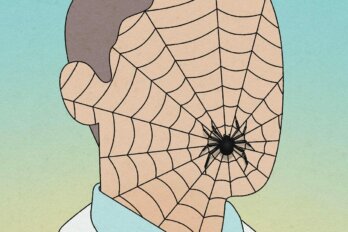“When they were about a year and a half,” says Felicia Hogan, “we got told it was impossible to separate them without harming or killing one.” Her eleven-year-old girls, Krista and Tatiana, are conjoined at the skull, making them craniopagus twins. Craniopagus twins are the rarest sort—only about 6 percent of conjoined people fall into that category. But the Hogan girls are rarer still because their skulls are not merely fused—instead, they form a single continuous cranium which houses four cerebral hemispheres.
In a new CBC documentary on their lives, Inseparable, director Judith Pyke invites us into the world of the sisters. The bond portrayed is more intimate, naturally, than nearly any sibling story, and yet its ramifications, its unspoken commentary on the nature of the self, is profound.
Around half of conjoined twins are stillborn, and when the Hogan girls were born in the autumn of 2006, doctors expected they would not survive their first twenty-four hours. When they did survive, parents Felicia and Brendan were next told the girls would become “vegetables,” stuck in bed and unable to eat, dress, or bathe themselves. Felicia and Brendan prepared to take their girls home, to Vernon, British Columbia. However, even before they left the hospital, they noticed something extraordinary about their girls’ behavior: when a pacifier was placed in one infant’s mouth, the other would stop crying.
MRI scans later revealed that each girl’s thalamus is connected to the other’s via a “thalamic bridge” that shuttles blood and brain activity back and forth. The thalamus acts as a hub for sensory information, so the girls are able to “tune in” to each other’s experiences. The extent of these shared senses makes the Hogan twins unique in the world. To try to understand the extent of this rarity, I spoke with professor Lewis Spitz, a leading expert on conjoined twins who has performed separation surgeries since before the days of MRI and 3D modelling—from back when surgeons would operate with little knowledge of the details of the conjoined people they were treating. Spitz told me he had never encountered any pair so intimately bonded as the Hogan girls.
They may be scientific miracles, but they are also just eleven-year-old sisters. They play together, annoy each other, support each other, are dedicated to Power Rangers. In Inseparable, we see Felicia (Mom) settling a squabble; we see the girls laughing about which one is the “evil twin”; we see them picnicking, visiting kangaroos at the zoo, and practicing their reading. In a tacit affront to the long history of exploitation that conjoined twins have suffered, Inseparable is decidedly human. In a wintry scene, Grandpa Doug describes the most honest of motivations: “You have two little girls, who happen to be joined at the head, wanting to toboggan. How can you say no? You can’t. We don’t tell them they can’t do something.” And so, though the adults fret over injury, the girls rocket, hollering, down the hill.
Limitations are everywhere, though. The girls are epileptic and must take a course of anti-seizure medications every night. They also have type-one diabetes and they’re allergic to gluten; and they’re developing, academically, at a delayed rate—in the documentary, they’re ten years old and working at a kindergarten level at school.
At the borders of these daily concerns, however, there hovers a whole fleet of philosophers and scientists. And the question they all get around to asking is this: What can these girls tell us about the self? The twins’ thalamic bridge (and its attendant sharing of taste, touch, and sight data) means that, without trying, they have confounded the most basic rule about having a self: your experiences are your own.
Anil Ananthaswamy, author of The Man Who Wasn’t There, has devoted years to studying the relationship between our bodies and our selves. He describes a theory of perception: one cannot perceive anything that hasn’t already been modelled in one’s brain. There is the story, for example, of a forest-dwelling tribe whose members, when brought to the sea, could not perceive ships because they had no mental model for them. So, as Ananthaswamy told me, “if a twin is perceiving a touch on the other twin’s body, then, by definition, she must have a model of the other twin’s body in her brain.” This would mean that each twin possesses a “model” of both bodies. On some level, and despite what most of us assume to be “natural” and given, their selfhood is shared.
It’s understood in neurological and psychological circles that the most fundamental sense of the self—and the oldest sense of the self—probably resides in our perception of our bodies in space. Multi-sensory experiences are the means by which the brain draws a line around our bodies. I see, hear, touch, taste, in order to navigate the world—and via this navigational process, I become an animal set apart, a sealed spaceship. We now know, however, that this sense of self is itself a construction. A woman has a stroke that shuts down the left side of her brain, and the barrier between her body and the rest of the universe appears to dissolve. A man suffering from body integrity identity disorder feels his arms no longer belong to him. A teenager takes a dose of ayahuasca, and the perceived envelope of the body falls away with the flip of a chemical switch. If the distinctness of the bodily self can be tampered with via such mechanical means, then we must begin to accept that the bodily self—that feeling we are whole, inviolate beings—is not due to some special soul, or “I,” resident behind our eyes.
Ananthaswamy sees reports of people losing their bodily self (by injury, disorder, or drug) as a great opportunity for the rest of us to learn. “When these things come apart,” he says, “we understand we are constantly constructing an in-body experience.” Perhaps the experience of being a person locked inside a bag of skin and bone—with that single, definable self looking out through your eyes—is not natural or given, but merely the result of a changeable, mechanical arrangement in the brain. Perhaps the barriers of selfhood are arbitrary, bendable. This is what the Hogan twins’ experience suggests. Their conjoined lives hint at myriad permeations of the bodily self.
Professor William Hirstein, a philosopher and cognitive scientist, has argued that our stubborn idea of the self as a private thing that cannot be tampered with actually keeps us from understanding it. We are still stuck, he believes, in a pre-Enlightenment vision of the “self” as a god-given soul, separate from the valves and tubes that make up the rest of our bodies. “By claiming consciousness is private,” he tells me, “we’re claiming that it is different from all other physical things and processes.” However, “if the twins can both be aware of a single conscious state . . . this would be an example of mind melding.”
Philosopher Colin McGinn once quipped, “If your friend is staring at something green, you cannot look at her and see the greeniness of her experience. Such intimacy is ruled out by the nature of consciousness.” He is sure of a private, secret self. And yet the Hogan twins do upend his assumption. Tatiana senses the greeniness of Krista’s experience all the time. “I hate it!” she cries out, when Krista tastes some spinach dip.
Do the twins, then, truly share a portion of their selfhood? Some bodily aspect of that experience we all think of as private to an inviolate degree? Or do the girls merely see shadows, copies, of consciousness? And—most unsettling of all—is that a distinction without a difference? These questions remain beyond our understanding of the mind. At one point during Inseparable, the twins seem to suggest they do share consciousness when, in passing, they remark that they can converse inside their heads. But then, too, they are utterly distinct (even discordant)—arguing over where to walk, when to rise, what to do. Their extraordinary experience remains confounding and secreted away inside their shared cranium.
Meanwhile, life is filled with daily—and, to them, more meaningful—challenges. The girls work to climb onto their specially designed bicycle. They tug on their specially knitted toque for two. And they are learning to swim. When the twins were little, less sure of their complex body, they refused to put their heads underwater. They’re braver now, more capable; their grandmother tears up when she watches them paddle in tandem and she proudly shrugs and says, “Who would have thought?”
Meanwhile, their mother plans another unlikely birthday: “It’s huge,” she says, holding out her hands in gratitude. And the girls agree. Krista looks into the corner of the room and suggests, “Someone has to put our face on money.” And the pair of them dissolve into mutual giggles.





